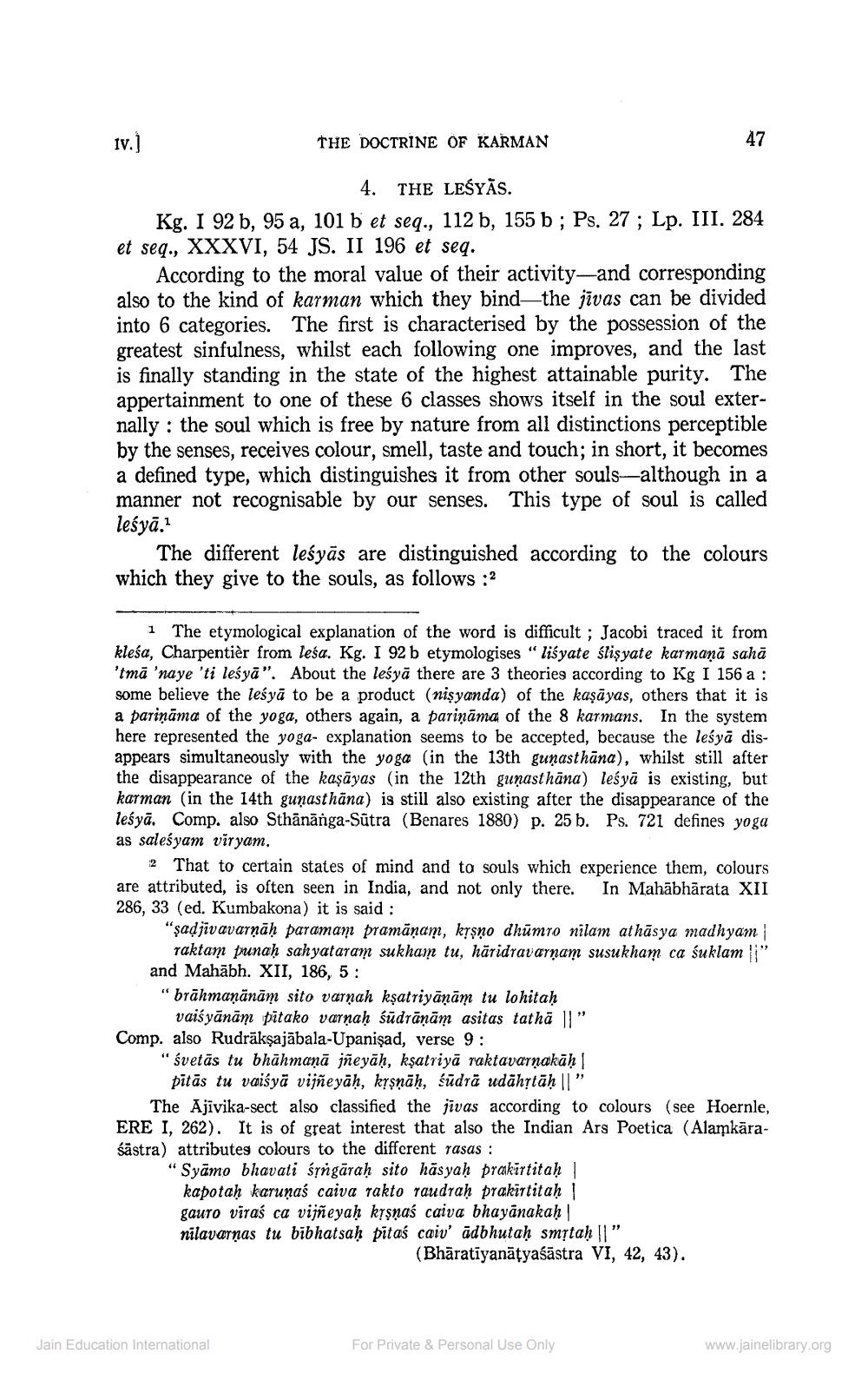________________
Iv.]
THE DOCTRINE OF KARMAN
4. THE LESYĀS.
Kg. I 92 b, 95 a, 101 b et seq., 112 b, 155 b; Ps. 27; Lp. III. 284 et seq., XXXVI, 54 JS. II 196 et seq.
According to the moral value of their activity-and corresponding also to the kind of karman which they bind-the jivas can be divided into 6 categories. The first is characterised by the possession of the greatest sinfulness, whilst each following one improves, and the last is finally standing in the state of the highest attainable purity. The appertainment to one of these 6 classes shows itself in the soul externally the soul which is free by nature from all distinctions perceptible by the senses, receives colour, smell, taste and touch; in short, it becomes a defined type, which distinguishes it from other souls-although in a manner not recognisable by our senses. This type of soul is called leśyā.1
The different lesyās are distinguished according to the colours which they give to the souls, as follows:2
1 The etymological explanation of the word is difficult; Jacobi traced it from kleśa, Charpentièr from lesa. Kg. I 92b etymologises "lisyate śliṣyate karmaņā sahā 'tmā 'naye 'ti lesyā". About the leśya there are 3 theories according to Kg I 156 a: some believe the lesyā to be a product (nisyanda) of the kaṣāyas, others that it is a pariņāma of the yoga, others again, a parināma of the 8 karmans. In the system here represented the yoga- explanation seems to be accepted, because the leśya disappears simultaneously with the yoga (in the 13th gunasthāna), whilst still after the disappearance of the kaṣāyas (in the 12th guṇasthāna) leśyā is existing, but karman (in the 14th gunasthāna) is still also existing after the disappearance of the lesya. Comp. also Sthānanga-Sutra (Benares 1880) p. 25 b. Ps. 721 defines yoga as salesyam viryam.
47
2 That to certain states of mind and to souls which experience them, colours are attributed, is often seen in India, and not only there. In Mahabharata XII 286, 33 (ed. Kumbakona) it is said:
“şaḍjivavarṇāḥ paramam pramāņam, kṛṣṇo dhūmro nilam athāsya madhyam | raktam punaḥ sahyataram sukham tu, haridravarnam susukham ca suklam ||” and Mahābh. XII, 186, 5: "brāhmaṇānām sito varnah kṣatriyānām tu lohitaḥ
vaisyānām pitako varṇaḥ śūdrāṇām asitas tatha ||"
Comp. also Rudrākṣajābala-Upanisad, verse 9:
"śvetās tu bhāhmaṇā jñeyāḥ, ksatriya raktavarṇakāḥ| pītās tu vaisyā vijñeyāḥ, kṛṣṇāḥ, śūdrā udahṛtāḥ || "
The Ajivika-sect also classified the jivas according to colours (see Hoernle, ERE I, 262). It is of great interest that also the Indian Ars Poetica (Alamkaraśästra) attributes colours to the different rasas :
'Syamo bhavati sṛngāraḥ sito hasyaḥ prakirtitaḥ | kapotah karunaś caiva rakto raudraḥ prakirtitaḥ | gauro viraś ca vijñeyaḥ kṛṣṇaś caiva bhayanakaḥ | nilavarnas tu bibhatsaḥ pitas caiv' adbhutaḥ smṛtaḥ ||" (Bharatiyanätyaśästra VI, 42, 43).
Jain Education International
For Private & Personal Use Only
www.jainelibrary.org




